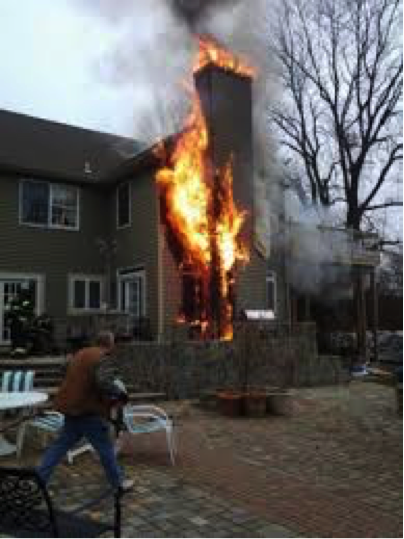Why do chimneys catch fire?
Chimney fires can burn slowly and quietly or dramatically explosive accompanied by noise not unlike a freight train or a low flying airplane. Flames or dense smoke may shoot from the top of the chimney. By burning seasoned wood and practicing proper chimney system care, chimney fires are entirely preventable.
Fireplaces and wood stoves are designed to safely contain wood-fueled fires, while providing heat for a home. The chimneys that serve them have the job of expelling the by-products of combustion – the substances given off when wood burns. As these substances exit the fireplace or wood stove and flow up into the relatively cooler chimney, condensation occurs. This is most prevalent in a smoldering or dampened-down fire. The resulting residue that sticks to the inner walls of the chimney is called creosote. Creosote is black or brown in appearance. It can be crusty and flaky, drippy and sticky (tar-like) or shiny and hardened. Often, all forms will occur in one chimney system.
Whatever form it takes, creosote is highly combustible. If it builds up in sufficient quantities and catches fire inside the chimney flue, the result will be a chimney fire. Although any amount of creosote can burn, firefighters are most concerned when creosote builds up in sufficient quantities to sustain a long, hot, destructive chimney fire.
Chimney fires don’t have to happen. Here are some ways to avoid them:
- Burn seasoned, thoroughly dried wood only. Dryness is more important than the type of wood being burned.
- Build smaller, hotter fires that burn more completely and produce less smoke.
- Never burn cardboard boxes, wrapping paper or trash; these can start a chimney fire.
- Have the chimney inspected and cleaned on a regular basis – at least, once a year.
What to do if you have a chimney fire:
If you realize a chimney fire is occurring, get everyone out of the house and call 911.
After calling 911 for fire department assistance and. if you can do so without risk to yourself, these additional steps may help save your home; however, remember that homes are replaceable – lives are not:
- Have a sandwich baggie full of baking soda near the fireplace and toss it into the fire; or, toss a small amount of water (less than one cup) on the fire.
- Cut off the air supply to the fire by closing dampers, fireplace doors, etc.
- From ground-level outside, if practical and safe, use a garden hose to spray down the roof (not the chimney) so the fire from the top of the chimney will not spread to the rest of the structure.
- Wait outside for the firefighters to arrive.
The Denman Island Fire Department can put out any fires in the structure, cool down the chimney and, using a thermal imaging camera, identify any remaining hot spots and deal with them appropriately. The Fire Department will also use its ventilating equipment to remove smoke from the house. Once it’s over, call a professional chimney specialist to inspect for damage before using the fireplace or wood stove again. Chimney fire damage and repair may be covered by homeowner insurance policies. Check with your agent.
Regular cleaning – Use only seasoned wood – No cardboard or trash

